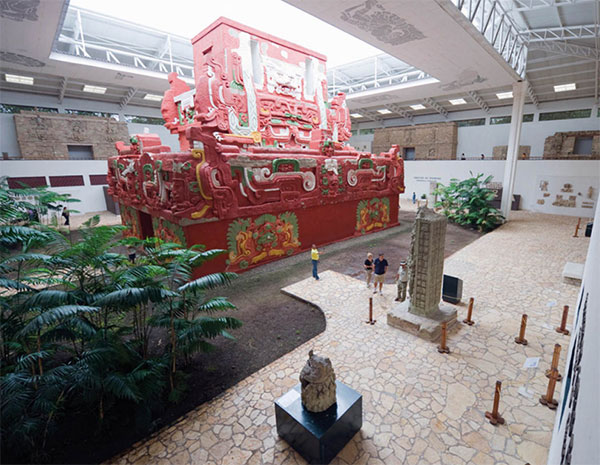Tip
Around 24km (15 miles) from Copán over rough mountain roads is the Luna Jaguar Spa Resort (www.lunajaguarspa.com), a lovely hot springs facility with a dozen or so pools and bubbling streams amidst thick rainforest. Their massage rooms are found in the Acropolis, a thatched-roof building overlooking a waterfall.
Near the main entrance is the Museum of Maya Sculpture, which contains some of the most important stelae and carvings found at the archeological site. At the center of the museum is a full-scale replica of the Rosalia Temple. The museum also contains the reconstructed original facade of one of Copán’s ball courts. Admission is included with your ticket to the park. The Copán Guides Association has a booth near the entrance, where bilingual guides offer two hour tours of the site.
About 2km (1.2 miles) from the main archeological site, Las Sepulturas was a residential area for Copán’s ruling elite. It was once connected to the Great Plaza by a broad path causeway, identified by NASA through satellite imaging, though it’s now reached on a leafy jungle trail. Admission is included.
Outside of Copán
Outside of town are forest-covered mountains hiding waterfalls and hot springs, plus superb bird-watching and other attractions. On the road to the border is Alas Encantadas (daily 8am–4.30pm), a butterfly garden and breeding project, plus a botanical garden with more than 200 species of orchids.

Mayan Rosalila temple replica at the Museum of Maya Sculpture.
Robert Harding
There are a few carvings of frogs and the figure of a pregnant woman at a small site called Los Sapos (daily 9am–5pm), across the river from Copán near the excellent country inn, Hacienda San Lucas (www.haciendasanlucas.com), which is known for its multicourse dinners using native techniques and ingredients. Several agencies in town offer horseback-riding tours here.
La Entrada and El Puente
At the intersection of highways CA 4 and CA 11, La Entrada 9 [map] is an otherwise uninteresting town that you would bypass if it weren’t for one spectacular attraction: El Puente (daily 8am–4pm). The ruins, 10km (7.5 miles) out of town, are of a Mayan city built between the 6th and 9th centuries and it is Honduras’ second most important archaeological site after Copán. Still, few actually visit it outside of the occasional tour bus. Several hundred stone buildings are scattered around the park and only a fraction have been excavated. There’s a small visitor center and museum at the entrance, from where it’s a walk of about a kilometer (a half mile) to the site’s primary attraction, a rather large pyramid.
Gracias
For a short time, the sleepy colonial village of Gracias a Dios – named after conquistador Juan de Chavez’s reaction after finding flat land after weeks in the mountains – was the capital of all of Central America. Eight years after being founded in 1536, Gracias ) [map] was home to the Spanish Royal courthouse with a jurisdiction that extended from Mexico to Panama. Four years later the court moved to Antigua and everyone forgot about Gracias for centuries.
Today, with nearby Lenca villages and national parks luring visitors, the town has been capitalizing on its stock of 500-year-old churches and cobblestone plazas. Much of the original Spanish grid, topped by a small fortification on a hillside called El Fuerte de San Cristóbal, has been reconstructed, with boutique hotels and cafés filling the whitewashed houses. Once the home of a wealthy colonial family, Museo Casa Galeano (daily 9am–6pm) is a restored colonial house from the 1840s stocked with artifacts, old photographs, and a folk art collection. It’s adjoined by a botanical garden, one of the oldest in the region.
The Balneario Aguas Termales (daily 10am–9pm), 6.5km (4 miles) south of Gracias, is a public hot springs amenity popular with locals and tourists alike. Surrounded by pine forests, the pools range from 33–35.5ºC (92–96ºF) and are relatively quiet outside of the weekend rush.
Parque Nacional Montaña de Celaque
One of the largest tracts of cloud forest remaining in Central America, Parque Nacional Montaña de Celaque ! [map] is the birthplace of 11 rivers that supply freshwater to villages as far away as El Salvador. Hidden within its pines and endless fog are resplendent quetzals, ocelots, and all sorts of rare flora and fauna. It’s not easy though. The trails through the park are rather steep and are often muddy. The difficult hike up the mountain of Cerro El Gallo takes about three or four hours, while other trails lead to waterfalls and mountain lakes. For the summit of Cerro de las Minas, the tallest peak in Honduras at 2,849m (9,344ft), camping on the mountain is essential for at least one night, with a guided hike requiring at least 2 days. Tour agencies lead guided excursions into the park, though some trails can be hiked independently.